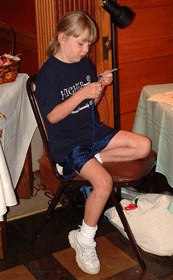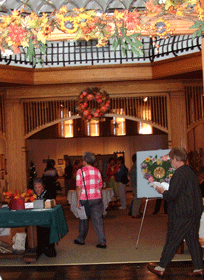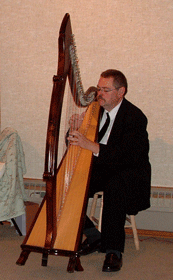I’ve been driving through South Dakota with all deliberate speed. Slowly, that is. I didn’t leave Minneopa State Park until late morning, and I didn’t go anywhere in much of a hurry. By late afternoon I was in Mitchell, South Dakota, where I’d been advised to visit the Corn Palace, apparently a whole building built of corn in an otherwise unremarkable town. Well, I visited the Corn Palace, but I found it rather unremarkable as well. It’s not built of corn at all. It’s a normal building with “mosaics” on the walls made of ears of corn in a variety of colors. Apparently they change every year, because on the front of the building a sign read “Life on the Farm 2005” – in corn, of course. Inside, the building is an auditorium. The Lippizaner Stallions were performing when I was there, but I ended up deciding not to go.
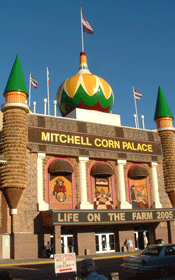 |
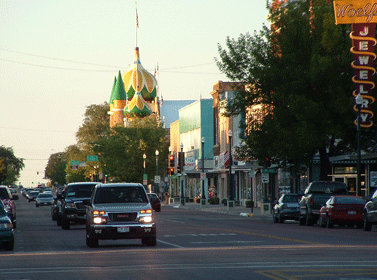 |
|
 | ||
With fifteen thousand inhabitants, Mitchell is one of the larger towns in central South Dakota. As the home of the Corn Palace it is a major tourist attraction, as none of the other towns seem to have anything to bring in outsiders. But that’s just my reaction. As Budd pointed out many times in Minneapolis, and again in response to my email about Mitchell and the Corn Palace, my perceptions are colored by the expectations I formed growing up in New York. I think cities should be densely populated places with dynamic street life, transited on foot, by bike, or by bus or subway. They should be rich with life, filled with a diversity of activity and people, rather than modest and uniform.
My expectations don’t encompass the reality of towns in sparsely settled rural areas. Towns form to offer things that demand a larger market than a few farms. So they offer supermarkets, hardware stores, bars, farm equipment, people to keep the roads in good shape and cleared of snow, courthouses, hospitals. That’s what most of the towns here are, and it doesn’t make for a very exciting mix, unless you’ve come there to buy clothes or gifts that you couldn’t get in the even smaller community nearest to where you live.
Mitchell, because it has the Corn Palace, attracts all of the tourists in central South Dakota, which in turn brings in a few other things – more bars and restaurants, a couple of coffee shops, some gift shops, other tourist attractions, shops selling to the tourists. And for the locals that makes it more fun than the other small towns around. Mitchell also has something else, according to the woman I chatted with in the local espresso joint. A lot of people there work in computer centers, like the Master Card one that is based in South Dakota. But she agreed that the shops in town didn’t do too well, opening and folding with regularity. She’d been born in Las Vegas, which she said was “ten years ahead of this place.” Her parents had been from Mitchell, though, and moved the family back when she was a teen-ager. She’s stayed to spend her life and raise her children there as well.
This morning I rode my bike around Mitchell Lake, a ten-mile loop that surely showcased the nicer homes in town. Many of them are in new lakefront developments; instead of growing steadily out from its center, the town has spun out in a line along the lake. In prehistoric times there was an Indian settlement on the lake, but now the town is largely further south. Perhaps it grew initially around the railroad line, a mile south of the lake, and then spread still further south when I-90 was built. Only now has it returned to the lake, as people have the resources to live further away from the railroad and the highway.
I stopped at a couple of events in Mitchell after circling the lake, a sewing exhibition at the YWCA and a crafts sale at the Masonic Temple. The YWCA building started its life as a Carnegie Library, and it is a lovely structure of heavy stone, with a dome encircled with an interior balcony. When the library moved to a newer structure, the old building became a museum to showcase the work of Oscar Howe, the “artist laureate” of South Dakota. A WPA project gave Howe funds to paint Indian designs on the inside of the dome back in 1940, and they are still there. Now the building is a YWCA, filled with brochures and posters encouraging the development of strong girls and strong women.
